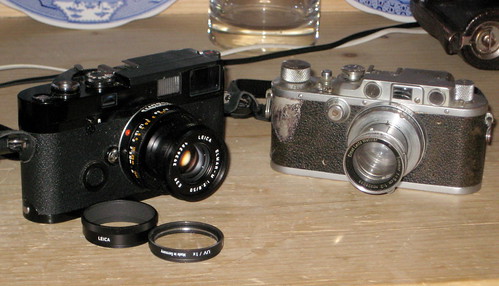
People criticise Leica for sticking to the M format with rangefinder (left), introduced in 1953 as a successor to the Leica III dating from the 1930s (right), saying it is just something to put in a glass cabinet. The real advantages of a Leica model M in practice apply to both film and digital versions.
(1) It is significantly smaller than an SLR, which means it is not an encumbrance.
(2) You can easily see what you are taking, and also what you are NOT taking, through the direct vision viewfinder, which has a feature to insert an extra eyepiece for those who wear spectacles.
(3) Focussing by rangefinder is positive and the photographer can decide what to focus on.
(4) The hardware is robust.
If digital SLRs are just too big, the problem with compacts is that their ergonomics are poor. Direct vision viewfinders, if fitted at all, are inaccurate and hard to see through. LCDs at the back of the camera are difficult to see in bright sunlight and do not show the image in real time. For anyone over the age of 45, it is necessary to hold the camera at arms' length to see the viewfinder, which is not a position where the camera can be held steady. And - a detail, but an important one - lenses are not provided with a thread for a UV filter, the main function of which is to keep the lens clean; dust etc can be removed by removing the filter and washing it under the tap.
Why the manufacturers have not addressed these simple points is a bit of a mystery because anyone bringing out a camera that did would have a best-seller.
Inga kommentarer:
Skicka en kommentar